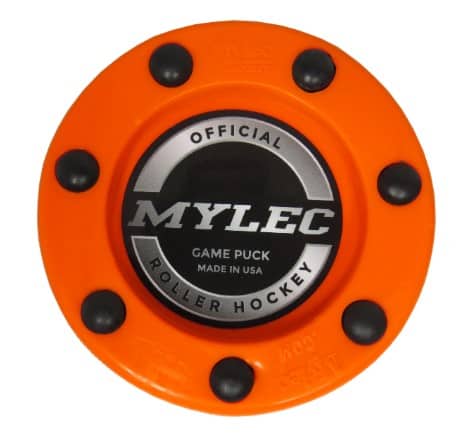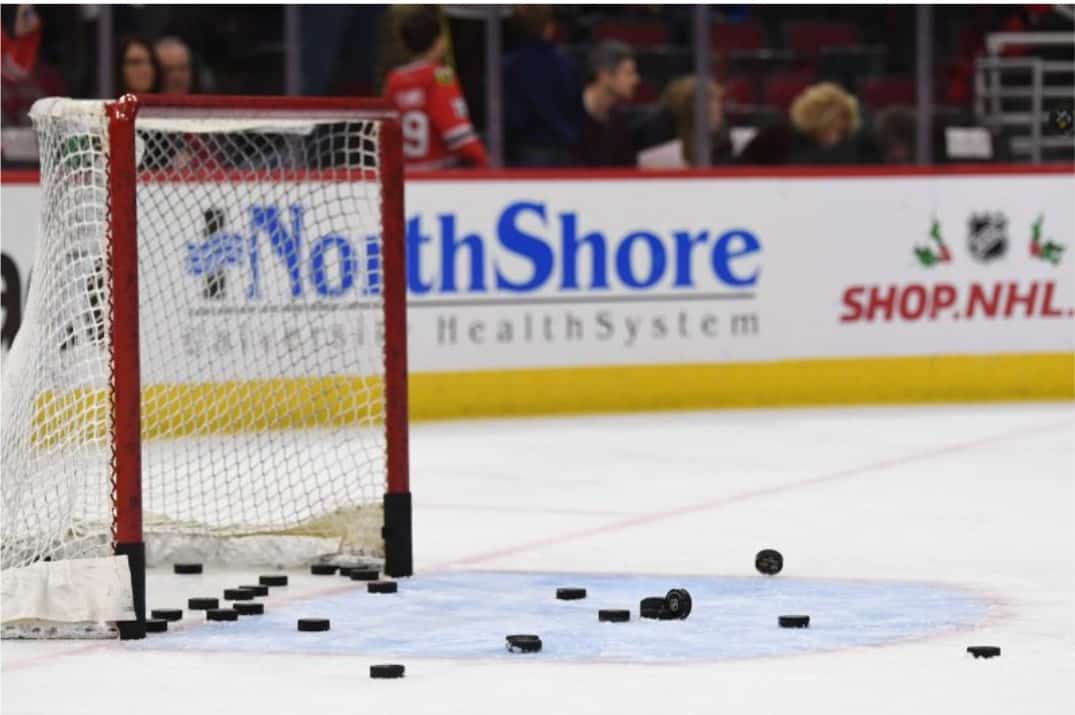Hockey pucks are a commodity in the game of hockey. You see them everywhere- players shooting them as hard as they can, fans watching them fly over the boards, or sitting on a mantle, signed by your favorite player. Pucks are an essential piece of the game we love, but how much do we know about them?
If you’re like me, you have never taken the time to understand the history of the hockey puck or how hockey pucks are actually made. Yes, they are made of rubber, but how do they get to their final round shape?
We will go through 12 things you should know about hockey pucks.
How Much do Hockey Pucks Weigh?
The standard NHL game hockey puck weighs 6 oz. They are black with the team’s logo on one side, and the NHL logo on the other. Sometimes the NHL will make pucks specifically for matchups, and print the logos of both teams on the same side.
Here is an example of the front and back of an Edmonton Oilers game puck.
Other pucks you can buy are made for training purposes or younger age groups. For kids that have trouble controlling the regulation weight puck, 4 oz. pucks are used for training and games. You will see them colored blue to identify a lighter puck.
Regulation hockey pucks are 1 inch (25 mm) thick and 3 inches (76 mm) in diameter.
What are Hockey Pucks Made of?
Hockey pucks are made of rubber. The fancy term for the type of rubber is vulcanized rubber. All this really means is heating up the rubber extremely hot and then it is placed into a form to create a hockey puck.
Here is a video from Sher-Wood Inglasco on how hockey pucks are made from start to finish.
Any puck that gets used in an NHL game, must be approved by the NHL league office.
Do Hockey Pucks Hurt?
The game of hockey is a rough sport. With all the other elements players must protect themselves from, one that is coming at the really fast is the puck. Evade them at all cost- pucks belong on your blade shaft or the back of the net!
Yes. Pucks hurt. They look innocent and feel light, but from personal experience, they will leave a mark. All hockey players will tell you many stories about getting hit in different places and the marks the puck left in its path. I took an innocent wrist shot to the shin without padding, and it sent me to the ice immediately and left a bruise that lasted over a month.
Even with modern technology, pucks still cripple a player blocking a shot on the ice. You see it all the time in the NHL.
With all the equipment goalies wear, they usually get off scot-free from any battle wounds from a puck. With goalie pads only a few inches, they can stop a puck coming 100+ mph and barely feel it.
Even with the extra netting around the glass, fans have been hit the pucks flying out of the rink. It is very sad to see but further proves pucks can do a lot of damage.
How Much do Hockey Pucks Cost?
One thing that is helpful about puck is they are very cheap. With the number of hockey pucks players go through, it is no wonder that factories are making hundreds of thousands of pucks every single year.
Hockey pucks cost $1.50 for a regulation, 6 oz. black puck. You can find an example on Pure Hockey’s website by clicking here.
If you shop on Alibaba or another foreign website, you can get them for $.50 apiece, but you never know what kind of product you are going to get. I have ordered from their website and was not impressed with the quality I received.
Like most products, if you buy in bulk, the price will decrease. Expect to pay around $1.00- $1.30 for buying in bulk. There are many different kinds of pucks. Weighted training pucks, lighter youth pucks, goalie practice pucks, etc. that will cost more than the standard size black puck.
Pure Hockey, as an example, has prices for many of those pucks on their website. Most of these pucks will not cost you more than $10.00 apiece.
You can buy hockey pucks at any sporting good store or the beloved Amazon. Dicks Sporting Goods, Academy, or if you are in Canada, Sport Chek.
What is the History of Hockey Pucks?
In the late 1800s, hockey teams would use 2 different kinds of ‘pucks.’ They would either use wood cut into the shape of a flat disc or cut a rubber ball until it was flat enough to slide on the ice. The original shape was square, not round.
There are 2 teams that are credited with using the first puck, although hitting an object back and forth on the ice has been around for a few years. The first recorded game of hockey in North America was either the Montreal Victorias or McGill University., thus they get the credit for using the first hockey puck.
In the late 1870s, the Montreal Victorias are credited with using the first round puck. This shape is the one hockey players use today. In Europe, the story goes that players would find a ball, and not air it up all the way for a puck. This would allow the ball to slide more on the ice rather than roll.
Today, Inglasco Inc. makes the official game puck. In 1980, the company signed the first exclusive contract with the NHL.
Since all pucks are the same weight and dimensions, many brands can make the same puck, but Ingslaco is the company that has the contract to supply the NHL with their game pucks. You can find their website here. They are headquartered in Quebec in Canada and produce pucks for the NHL, AHL, ECHL, and the Canadian and USA National Hockey Teams.
Although Inglasco produces the official NHL puck, there are manufacturers across the world pumping out thousands of pucks. Because pucks are so common, there are many countries that make pucks every year.
Do they Freeze Hockey Pucks?
If you have ever watched a hockey game and saw players or officials pulling a hockey puck out of a cooler, you might wonder what they are doing.
Think about tennis or lacrosse and how much those balls bounce. Since the pucks are made of similar rubber, they have a tendency to bounce. The object of the puck is to slide, not to bounce, so the league came up with chilling the pucks to make them harder. At the AHL and NHL levels, all hockey pucks are frozen before games.
If you do not freeze the pucks, the puck will be noticeably more bouncy. From a player’s perspective, it is harder to control when the puck hits your stick or releasing the puck towards its next destination. When you receive the pass, you want the puck to stick to your blade, not bounce right off. Freezing the pucks help the pucks slide across the ice and have less bounce when they come into contact with an object.
Even in lower leagues, you will see teams freeze pucks to enhance play on the ice, but at the AHL and NHL level, it is mandatory. They are kept in a small cooler in one of the penalty boxes at 14 degrees Fahrenheit. Officials throughout the game will monitor the temperature of the puck. If a new one is needed, the linesman will skate over to the box and grab another one. This is also why officials will leave the puck on the ice during the game, keeping it out of their hands as much as possible.
When a puck gets to 25 degrees Fahrenheit, the refs will remove the puck and replace it with a frozen one. This is executed at ref’s discretion, as they do not have a thermometer that will measure the temperature for them. They have officiated hundreds to thousands of games by the time they get to the top levels, so they have a good feel for the pucks.
The NHL has even experimented with covering the pucks with a color coating formula that changes to clear when the puck is above freezing and needs to be replaced. This not a rule, but the NHL has been known to test it in specific games, mainly the outdoor ones they host every year.
How Fast do Hockey Pucks Go?
Hockey pucks go as fast as the players can shoot it. In the NHL and other top leagues around the world, players slap shots have been recorded north of 100 mph. Most NHL players slap shot is the 90 mph range, with the elite shots over the 3 figure mark. A top tier women’s player can shoot the puck 80 mph.
Hockey Puck Nickname
One of the first terms used to describe a hockey puck was ‘flat ball.’ Because hockey pucks were formed by cutting down a rubber ball into a more flat, square piece, they adopted the name flat ball.
Another common term used for a puck is ‘biscuit.’ Hockey players will use the phrase ‘I put the biscuit in the basket’ to refer to scoring a goal.
How Many Pucks are Used in a Game?
Because hockey pucks are made of very light rubber, they get damaged very easily when a full-grown man or woman leans into a slap shot, exerting all their strength into the puck.
Per the NHL, 40-45 pucks are used for each game. That is a lot of pucks. Some games will use less than 40, it just depends on what goes on in that game.
Many factors, as we discussed earlier, go into switching out the pucks. If the puck becomes to warm, it goes back into the cooler to get frozen. If an official sees a puck is damaged, they will switch it out for a new one. If the puck makes its way to the stands, it’s a souvenir and they grab another one.
As you move into lower levels, puck rules become less important. As long as the puck is not damaged, they will reuse pucks as much as possible. Also, freezing the pucks is not an essential piece of puck management outside the professional leagues.
Why are Hockey Pucks Black?
Hockey pucks are black for a couple of reasons. The rubber used to create the pucks is naturally black. Producers can change the colors of the puck if needed, but it is easiest to keep them black.
Conveniently so, black is the easiest color for everyone to see on the ice. Because the game moves so quickly and the puck is so small, black is the perfect color for fans and players alike to track what is going on. Black makes it easy for officials to notice if the puck crosses the goal line completely or not. With cameras hovering over the goal line in the modern game, there is no discrepancy on the puck crossing over the line completely.
Goalies are not allowed to have black tape on their sticks, as this would interfere with the officials’ site of goal or no goal.
What is a Roller Hockey Puck?
The official roller hockey game puck is made by Mylec. You can find it on Amazon here. You can find it in 3 different colors and weighs about 3.8 oz.

When most people talk about roller hockey pucks, they are referring to any kind of street puck.
There are so many options when it comes to off-ice pucks. If you are like me, you played with a tennis ball or whatever you could find that would roll. Today, there are too many options to choose from. There at least 12 to 15 common pucks that producers have tried to come up with and get players to use. There is nothing like the real thing, but there are a few that come close.
Check out this video by Coach Jeremy as he reviews 10 different off-ice pucks. Keep in mind, this is not on synthetic ice, but on the street.
His favorite and most other hockey player’s favorite is the Green Biscuit Roller Puck, which you can check out at Pure Hockey’s website here.
Off-ice hockey pucks have risen in popularity recently with warmer temperatures staying around longer and more at-home training products available to the public. Street hockey is not new, but the rise of synthetic ice is increasing in popularity. You can find out more information about synthetic ice in a post I wrote here.
Roller Hockey Puck Weight
Manufacturers try to make the street hockey pucks weigh the same as regulation pucks (6 oz.). The Green Biscuit, for example, weighs 3.6 ounces. Some street pucks weigh more for training purposes. The official street puck weighs 110 grams or 3.8 oz.



